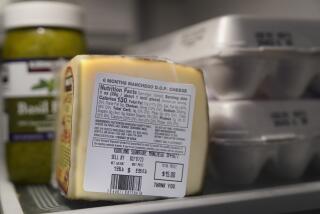The Wax Treatment: Produce Beauty Secrets Revealed
- Share via
The worst-kept secret of the produce industry becomes public knowledge Sunday when supermarkets will be required by the federal government to identify all fresh fruit and vegetables that are commercially coated with wax.
For those shoppers still in the dark at the produce counter: The shine and slippery gleam on apples, cucumbers, citrus, tomatoes--and nearly two dozen other commodities--is not the work of Mother Nature but more like the magic of industrial cosmetics.
The new disclosure regulation, in the works for several years, has been all but ignored in the attention provided the comprehensive nutritional labeling requirements for processed foods that also go into effect Sunday. The U.S. Food and Drug Administration will oversee compliance on both the nutrition and wax labeling.
Yet consumers may find that the wax disclosures will be more prominent than the new fine print on soup cans and cereal boxes. All coated produce will now carry shelf tags or package labels identifying the presence of a resinous covering. In addition, some supermarket chains will post banners with the government-required language on waxing and a list of all fruits and vegetables that might be affected.
*
Currently, produce packing companies use a variety of food-grade coatings including vegetable-, petroleum-, beeswax-, or shellac-based waxes or resins.
“The use of wax on food goes back 2,000 years to when the Chinese used to dunk things in beeswax or paraffin to preserve it,” says John McClung, vice president of the United Fresh Fruit and Vegetable Assn., an Alexandria-based trade group. “Today, waxes are used for several purposes, but mostly on thin-skinned items to prevent (dehydration) and wrinkling. Citrus is thick-skinned but porous and also needs a coating. Wax is used on melons to act as a barrier against bacteria and fungus. And, of course, wax is applied for cosmetic reasons--to make produce attractive.”
Originally, the issue became a concern because of religious and/or lifestyle reasons. There was a time when the produce industry used an animal-based wax from rendered tallow for fruit and vegetable coatings that would be objectionable, for instance, for those on kosher regimens or vegetarian diets.
Ironically, research conducted by the United Fresh Fruit and Vegetable Assn. found that no animal-based waxes are currently being used on domestic or imported fresh produce.
“This whole thing was never a public health issue but a consumer-right-to-know issue,” McClung says. “Nobody has used tallow for a long time because it’s not as good as other coating agents.”
*
However, a 1987 publication by the Natural Resources Defense Council claims that produce waxes do play a role in the food safety debate.
“(Waxing), in effect, seals the pesticide residues in the food,” reads the NRDC report. “In fact, some pesticides are even combined with the waxes. For instance, waxes applied to citrus and tomatoes may contain fungicides.” The report also stated that the waxes, by design, can not be washed off.
At the same time, some segments of the produce industry are steamed at the new requirements.
Sunkist Growers Inc., the Sherman Oaks citrus cooperative, is stuck with about $3 million in packaging that can not be used under the new regulation, according to Claire Peters, Sunkist spokeswoman.
The packaging will have to be reprinted or additional inserts will be needed in order to comply with the law. Both, she says, are expensive propositions.
*
Representatives of the apple industry, on the other hand, are considering whether to discontinue using wax on their commodity altogether. Under the regulation, growers can label their produce stating that “no wax or resin” was used.
Local supermarkets have already begun to comply with the wax regulation.
Julie Reynolds, spokeswoman for the Vons Cos., says the chain last week began installing posters on waxing. She says that some consumers’ buying habits may be negatively influenced by the wax disclosures but didn’t express any great concern about sales losses.
The timing of the regulation comes on the eve of the first harvest of California’s major summer fruit crop, much of which will be flagged for the first time as being waxed.
More to Read
Inside the business of entertainment
The Wide Shot brings you news, analysis and insights on everything from streaming wars to production — and what it all means for the future.
You may occasionally receive promotional content from the Los Angeles Times.










